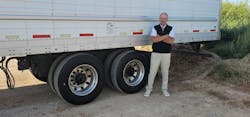Key Highlights
- Wheel-offs are often preventable; studies show that failed fasteners are responsible for the majority of these incidents, emphasizing the need for proper inspection and torque application.
- Innovative safety devices, such as Billy Turner's TetherTech, are designed to prevent wheel-offs and protect lives, inspired by real tragedies like Justin Sullivan's death.
- Consistent, careful inspection and maintenance of wheel-end components can significantly reduce the risk of accidents, saving lives and avoiding costly disasters.
One of my first memories in school was on a January day in 1986. The teacher rolled in a cart with a chunky television on top and turned it on in preparation for a very special space shuttle launch. A high school teacher from New Hampshire was on board the Challenger, so that made it a big deal to our educators. I’m quite sure we were just happy to get a break from phonics. But a little over a minute after launch, the Challenger exploded in the sky, with all seven astronauts dead, having never left the atmosphere.
The only person I remember being emotionally scarred from the incident was a girl named Punky Brewster, but when I learned the cause of the accident, it did leave a lasting impression. It turns out the $9 billion shuttle (in 2025 dollars) and seven explorers were lost due to a faulty O-ring. The weather was unusually cold at Cape Canaveral that day, and the rubber gasket lost its elasticity, allowing gas to escape and sear through a strut, causing a chain reaction that exploded the external fuel tank.
The point is, overlooking even the smallest detail can end up in disaster.
This would further be impressed upon me during my days as a submariner. If you think the vacuum of space leaves zero margin for error, imagine being hundreds of feet under the ocean, on a warship loaded with dozens of torpedoes and missiles, a nuclear reactor, life support systems, and a bunch of dysfunctional dudes, most of them in their late teens and early 20s, with nowhere else to go. As a sonar tech, I'd often work on energized gear, and in port have to hang upward of 100 danger tags (our lockout/tagout system) on various valves forward and aft to prevent divers from being killed inspecting the keel. We would do this every time we got to port and it required a very tedious process involving several crew members. This was to ensure any mistake was caught, but if two people overlooked the same error—a valve in open instead of closed, for example—one of our friends could die. Rushing the job just so we could get off the boat and see the sun and breathe real air once again was never an option.
This is why I always find myself thinking about the butterfly effect in wheel-end maintenance: A simple miscalculation in torque can ripple into a deadly wheel separation. If you’re a regular reader, you’re probably sick of hearing so much about the dangers of wheel-offs.
They make me sick, too, because they are so dang preventable. A 2016 study by Ontario’s Ministry of Transportation found failed fasteners were the cause of 80% of wheel separations, and failed bearings 10-15%. Proper inspection and installation using the R.I.S.T. (Remove/Inspect/Snug/Torque) method should catch a great deal of these. We explained these in more detail in here.
Technicians need to remove the wheel-end assembly for all sorts of work on wearable components like brakes and tires. Each time that happens is an opportunity to make sure studs and lug nuts are in good shape. And no matter how monotonous it seems, do it the right way every time with a torque wrench you know is correctly calibrated.
A 1992 NTSB report estimated there were at least three heavy truck wheel separations per day, based on reported events. It’s likely much higher.
We only hear about the ones that kill people, like the one in April 2024 that killed a Kentucky truck driver. The driver of the other tractor-trailer didn’t even realize his trailer lost a wheel and police only found him after checking local shops. The fact is every time you don’t follow wheel-end maintenance best practices and casually tighten the fasteners is like playing Russian roulette, spinning a revolver’s cylinder and hoping the bullet isn’t chambered.
And what’s the true danger if your apathy or oversight does cause a wheel-off?
“It’s killed people sitting in their house watching TV,” noted Billy Turner, a former fleet owner who felt compelled to invent the TetherTech Wheel Safety System, a series of special hubs connected through the axle by a steel cable that has shown in stress tests not to fail.
He also noted that similar to space shuttles, “you can forget one 50-cent washer, and have the whole thing come off and kill somebody.”
He spent years engineering the solution after one wheel-off event hit very close to home.
It was June 3, 2002, just outside of Oklahoma City. A dual-wheel assembly came off a tractor-trailer, shot down the highway, and slammed into the windshield of an SUV driven by Justin Sullivan, killing the 18-year-old. Just the day before, The Oklahoman named Sullivan the Baseball Player of the Year. A day later, that same paper was reporting the details of his death. Apparently, the catcher swerved into the 800-lb. loose assembly to absorb the impact, protecting his passengers.
His family—who were all excitedly wondering where in the Major League draft he would land—were now planning his funeral. Sullivan had brains, too, finishing third in his class with a 4.33 GPA. The most important thing in his life, though, was leading a life of faith and humility.
If not for a mistake unnoticed by the driver and likely at least one shop, this young man would have gone on to do something great. But maybe he did, because his passing inspired Turner to create his device, which may go on to save many more people.
It’s not the only wheel-end product that can prevent wheel-offs and improve overall safety and efficiency. I encourage you to follow the guidance from manufacturers and best practices from organizations such as the Tire Industry Association and Technology & Maintenance Council. And do your own research.
But if you do buy Turner’s device and wonder why every part number begins with the letters JDS, know that it’s for Justin David Sullivan. And you can honor Justin and the many more who die every year by giving even a few more seconds of scrutiny every time you inspect or service a wheel-end at your fleet or shop. You never know the impact of that attention—or inattention—to detail could mean down the road.
About the Author

John Hitch
Editor-in-chief, Fleet Maintenance
John Hitch is the award-winning editor-in-chief of Fleet Maintenance, where his mission is to provide maintenance leaders and technicians with the the latest information on tools, strategies, and best practices to keep their fleets' commercial vehicles moving.
He is based out of Cleveland, Ohio, and has worked in the B2B journalism space for more than a decade. Hitch was previously senior editor for FleetOwner and before that was technology editor for IndustryWeek and and managing editor of New Equipment Digest.
Hitch graduated from Kent State University and was editor of the student magazine The Burr in 2009.
The former sonar technician served honorably aboard the fast-attack submarine USS Oklahoma City (SSN-723), where he participated in counter-drug ops, an under-ice expedition, and other missions he's not allowed to talk about for several more decades.

